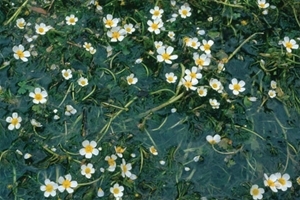 This work was made possible with the kind support of The G & K L B Boyes Charitable Trust
This work was made possible with the kind support of The G & K L B Boyes Charitable Trust
New research has found that water crowfoot – an aquatic plant found commonly in lowland rivers – has multiple benefits for young Atlantic salmon, and that active management of the plant could be important for the conservation of this iconic and declining fish.
Water crowfoot (Ranunculus) is an aquatic member of the buttercup family found in clean gravelly lowland watercourses. A classic component of chalk rivers, this plant is vulnerable to low flows, pollution and physical loss from leisure activities, weed cutting and swan grazing.
A PhD research project conducted by Dr Jessica Marsh at the Game and Wildlife Conservation Trust (GWCT) in conjunction with Queen Mary University of London (QMUL) has shown that high coverage of water crowfoot is associated with more and better-growing young salmon.
Her findings are significant because populations of salmon are declining steeply, and a part of the solution might be to restore high coverage of water crowfoot in lowland salmon rivers.
READ THE VISUAL SUMMARY >
Jessica explained: “Populations of wild Atlantic salmon are in decline throughout most of their range, and the rivers of southern England are no exception. Brown trout are also facing pressures from predation, habitat degradation, pollution and warming water temperatures. It is important to ensure that young fish have the best possible habitats in which to thrive. Our research identified that instream aquatic vegetation has benefits for young salmon (and to a lesser extent, trout), and demonstrates that river restoration aims for lowland rivers might be achieved through the promotion and even enhancement of naturally occurring Ranunculus beds to improve the production of both salmon and trout.”

Jessica designed an experiment on the River Frome in Dorset whereby water crowfoot plants were physically redistributed to make areas of low, medium and high plant cover. These sites were monitored for two years to investigate the effects of water crowfoot cover on the abundance, growth rates, feeding opportunities and competition between salmon and trout. Across three published scientific papers, Jessica reveals how young salmon and trout benefit directly from the physical shelter that water crowfoot provides, as well as indirectly through provision of prey and diversity in depth and flow.
Previous GWCT research suggests that salmon leaving the river as ‘smolts’ in a good condition and large size are more likely to survive their Atlantic migration and return to breed. The key to achieving good body condition and size lies in the river habitat and resources in the fishes’ first summer, and Jessica’s research found that the latter is strongly influenced by water crowfoot abundance.
Dr Rasmus Lauridsen, Head of Fisheries Research at the GWCT and supervisor of the study, said: “Wild salmon populations have declined dramatically, in some areas by as much as 70-80% in the last 30 years. The GWCT has been monitoring salmon numbers in the River Frome, at our Salmon & Trout Research Centre since 1973, creating one of the most comprehensive records of salmon movement and survival in England and Wales.
“As a wildlife conservation organisation with an internationally recognised research centre for salmon and trout, we strive to support research that is both scientifically robust and has practical applications. Dr Marsh’s study illustrates how habitat quality impacts production of young salmon and trout and the findings have clear management applications for river restoration techniques in lowland rivers.”
Prof Iwan Jones, Head of the River Communities Group and supervisor at Queen Mary University of London, said: “This research has shown that by promoting the naturally occurring Ranunculus beds that are so characteristic of our lowland rivers we can improve conditions for other threatened species, such as salmon and trout. Lowland chalk streams suffer from many pressures: this work has implications for how best to restore these important rivers and the species that live in them.”
Notes to editors
The Game & Wildlife Conservation Trust – providing research-led conservation for a thriving countryside. The GWCT is an independent wildlife conservation charity which has carried out scientific research into Britain’s game and wildlife since the 1930s. We advise farmers and landowners on improving wildlife habitats. We employ more than 60 post-doctoral scientists and other research staff with expertise in areas such as birds, insects, mammals, farming, fish and statistics. We undertake our own research as well as projects funded by contract and grant-aid from government and private bodies.
For information, contact:
Eleanor Williams
Telephone: 07592 025476
Email: press@gwct.org.uk